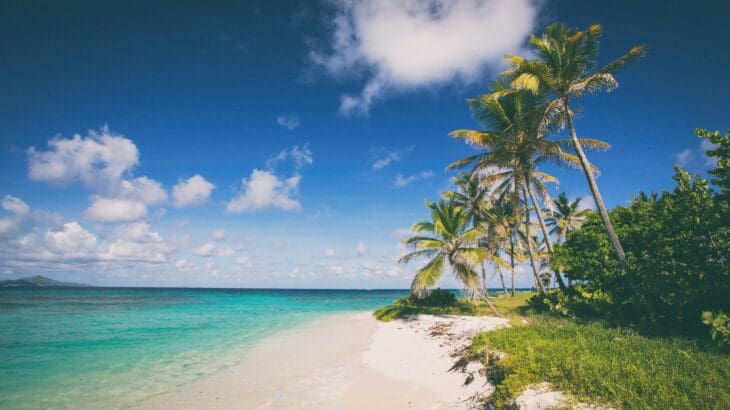The Caribbean Climate-Smart Accelerator, formed in response to the 2017 hurricane season, is an entrepreneurial engine, setting an ambitious agenda to create the world’s first “climate-smart zone”. The coalition, which includes 26 countries and over 40 private and public sector partners, seeks to catalyze transformative investments and partnerships across priority areas including clean energy, resilience, sustainable cities, oceans, and transportation.
Following a high-profile kick-off in the summer of 2018, the Accelerator was off to a strong start, securing the support of regional government leaders and financial commitments from – amongst others – the Inter-American Development Bank and the World Bank. While the aim is clear, the roadmap and the impact remain uncertain.
After nearly a year, what kind of footprint has the organization left on the region? We sat down with the CEO, Raquel Moses – a Caribbean business veteran appointed in early 2019 – to ask about the priorities for the year ahead, regional innovations in finance, and which countries are pulling ahead in the race for resilience.
New Energy Events: What are the top priorities for the Accelerator in the coming year?
Moses: There are quite a few things that we’d like to accomplish in the next year, but everything can’t be a priority. We’d really like to complete our initial project development cycle with each of the countries in our portfolio [editor’s note: 26 partner countries] as well as add the additional three countries that we believe would really round out the regional approach.
I’d also like for us to move past the assessment phase with our first billion-dollar project within the portfolio. We would want to have incubated at least $50 million in projects and have completed over $10 million in project value. Our aim would be to have at least five of our partner countries increase their use of renewable energy generation. I’d also like to see a balanced pipeline across our four primary pillars. [Editor’s note: The four pillars include building resilient communities, accelerating socio-economic development, the creation of jobs, and advocacy for Caribbean development on the global stage.]
Can you give us a preview of the Accelerator’s project pipeline? Have common themes emerged across the potential projects?
We have eighteen renewable energy projects. We are focusing on projects where our impact will be meaningful and our intervention is critical to the success and completion of the project. Many of the projects in our pipeline are at an early stage and progressing sufficiently that our intervention may not be necessary in order to get them to the point of completion.
In our energy portfolio, we have solar, wind, geothermal, and waste-to-energy. Most of our active support is in the waste-to-energy area.
We have seven resilient infrastructure and smart city projects. This is an area where we anticipate a great deal of growth.
We have three electric vehicle projects, most involving multiple countries. These projects are our most regional in nature and we’re actively working towards developing innovative means of bringing financing solutions to these projects.
We have approximately six maritime and agriculture projects ranging from coastal resilience and protecting mangroves, to an unprecedented regional clean-up effort.
What’s the level of interest you’re hearing from global investors in the Caribbean?
We are definitely seeing interest – we have managed to attract some Fortune 500 partners – but not nearly enough. What we need to do is pool our data so that global investors can see how exciting the region is. Our collective offering is compelling in terms of access to talent as well as opportunities to create solutions.
Are you seeing any trends in how clean energy projects are being financed? Will these trends inform how projects are financed through the Accelerator?
For financing of clean energy, we’re seeing suppliers that are bringing capital or financing solutions to the table pushing innovation. For example, we’re working with one waste-to-energy provider that is funding the capital cost and implementing an especially innovative PPA arrangement.
We’re seeing innovation in other areas, too. In the oceans space, we’re seeing a lot of talk about blue bonds. Blue bonds are similar to debt for nature swaps that are focused on marine conservation and fisheries projects. While there has been successful debt for nature swap efforts, blue bonds are a new approach recognizing the vulnerability and urgency of protecting our marine assets. We’re also seeing nature-based insurance which funds maintenance and restoration reducing sovereign risk. We’re seeing the creation of regional risk pools for small island developing states which reduces costs by balancing regional risk. We’re also seeing resilience bonds as well as traditional debt for nature swaps.
In your view, what are the most interesting markets in the Caribbean right now?
To be honest we’re seeing a lot of interesting development in all of our partner countries. Certainly, we hear a lot about Barbados and Jamaica and are incredibly proud of the bold decisive action that they are taking. We’re seeing exciting developments in the British Virgin Islands and of course in Dominica led by the Climate Resilience Execution Agency for Dominica (CREAD).
We’re seeing an increased exploration of renewable energy opportunities in the OECS and spectacular ocean conservation efforts in Belize. Haiti, against all odds, is doing a great deal in terms of investing in their infrastructural resilience, despite their economic challenges and the torrent of natural disasters experienced in the last decade.
Racquel Moses will be a featured speaker at the upcoming 11th Caribbean Renewable Energy Forum. More information on CREF available here.


